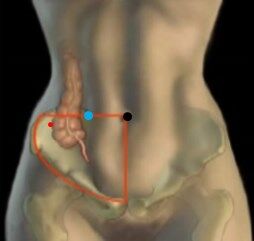Hengliang Zhu, MD. The First Affiliated Hospital of Wenzhou Medical University
Laparoscopic appendectomy (LA) is probably the technique of choice in acute suppurative, gangrenous and perforated appendicitis. A variety of trocar placements in complicated appendicitis might indicate a failed satisfaction with the procedure in conventional three trocar technique LA. To develop a better procedure for LA, Dr. Hengliang Zhu initiated a novel approach to trocar placements, named “Zhu's Trocar Placements” for the sake of convenient description, in complicated LA.
Zhu's Trocar Placements (ZTP) is defined as (Fig.): (1) the first trocar: a 10-mm umbilical port site for the laparoscope, (2) the second trocar: a 10-mm port site at the cross of the umbilical level and the right midclavicular line, where the resected appendix pulled out. (3) the third trocar: a 5-mm port site at the cross of 1~3 cm below the umbilical level line and the right anterior axillary line, through where a drainage tube giving considerations to both the Douglas pouch and right iliac fossa, and (4) a consequently novel surgeon's position: the surgeon stands on the right side of the patient while the cameraman on the left side.
Complicated appendicitis has been defined as the presence of perforation, gangrene, serious periappendicular inflammation, intestinal tympanites, intra-abdominal abscess or mass formation (a plastron).
A retrospective analysis of 26 patients with complicated appendicitis who had undergone the “ZTP-LA” between June 2013 and August 2014 was performed. There were no conversions to laparotomy. In both the conventional LA and the ZTP-LA group, the incidence rates of postoperative incision infection, secondery bleed from the appendicular artery and incision hernia were zero. Compared with the conventional LA group, the ZTP-LA group showed a much shorter video-based operation time ( 28 ± 8 min VS 43 ± 15 min, p<0.01) and less incidence rate of postoperative intra-abdominal abscess (p<0.05).
ZTP-LA is safe, feasible, and shows much shorter operation time and better drainage of postoperative intra-abdominal abscess in terms of complicated appendicitis in this preliminary report. Present data support ZTP-LA to be a potentially standardized technique for complicated appendicitis. A prospective randomized controlled trial (RCT) study should be and has been conducted by Dr. Zhu (Additional prospective data collected from October 2014 are in processing and may be present before March 2016).
